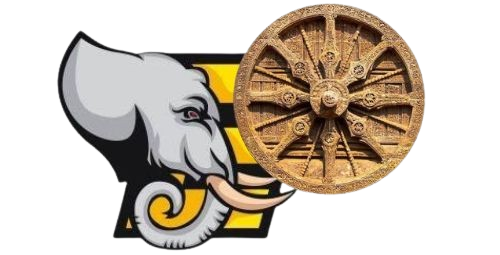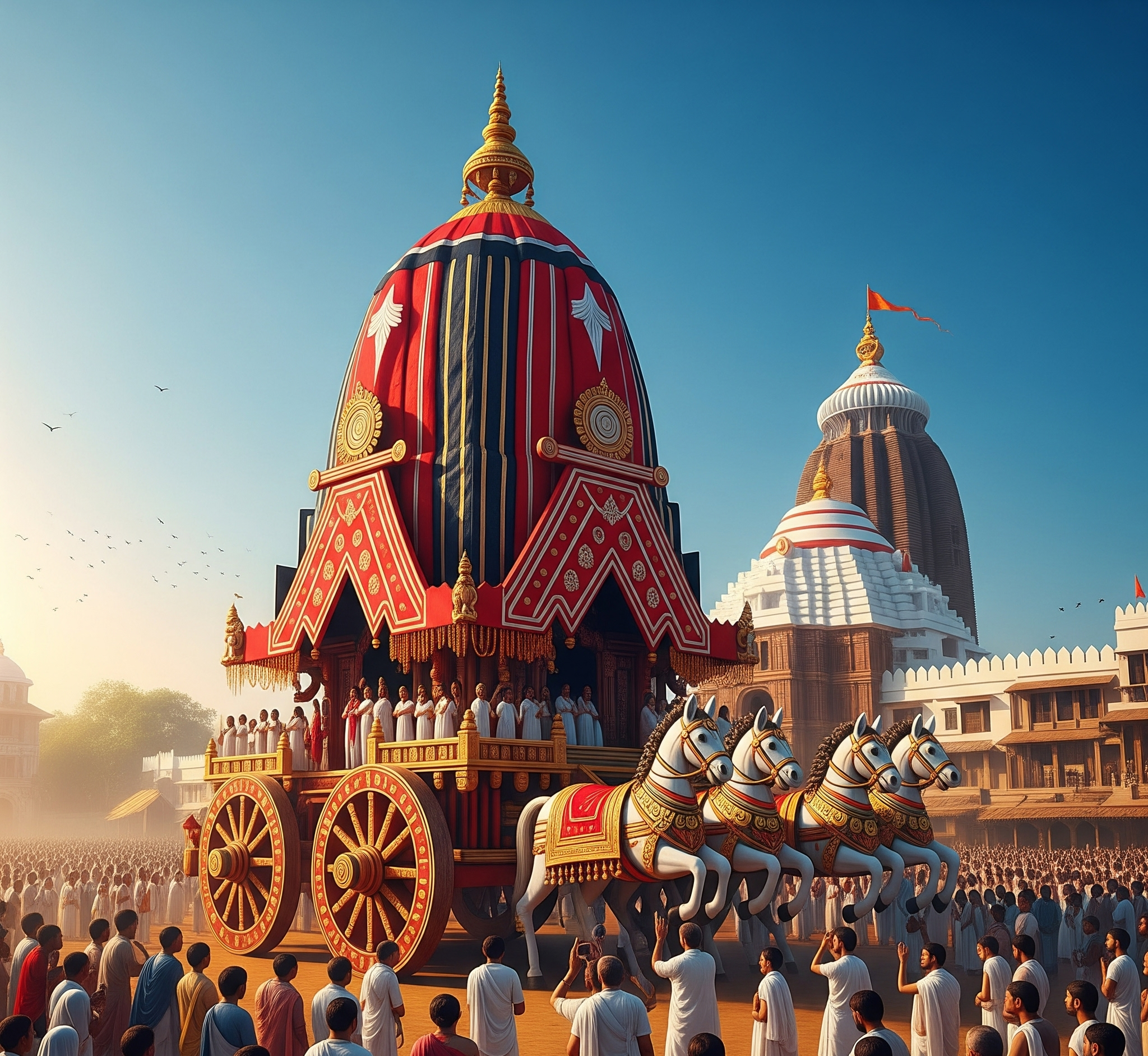Certainly! Below is a sophisticated, original, and plagiarism-free 1000-word article for your website on:
and Its Sacred Origin
The annual Rath Yatra of Puri is one of the grandest and most spiritually charged festivals in India, attracting millions of devotees from across the globe. At the heart of this magnificent event lies the journey of the three divine siblings—Lord Jagannath, Devi Subhadra, and Lord Balabhadra—from the Jagannath Temple to the Gundicha Temple in their respective chariots. Among these, Lord Balabhadra’s chariot, known as Taladhwaja, holds a unique and deeply symbolic place in the sacred traditions of Odisha.
The story of Taladhwaja is not just about wood, wheels, and architecture—it is a profound expression of divine identity, ancient symbolism, and spiritual philosophy. This article dives deep into the origin, construction, symbolism, and significance of Lord Balabhadra’s Taladhwaja chariot, revealing how it embodies the values of strength, righteousness, and cosmic balance.
Who is Lord Balabhadra?
Before exploring the chariot, one must understand the deity. Lord Balabhadra, also known as Balarama, is the elder brother of Lord Jagannath (a form of Krishna) and Devi Subhadra. In Vaishnavite traditions, Balabhadra is revered as the embodiment of Shesha Naga, the eternal serpent on whom Lord Vishnu rests. He represents physical strength, agricultural fertility, and moral righteousness (Dharma).
He is often depicted with a plough (Hala) and a mace (Gada), signifying his connection with the earth, farming communities, and protection. In the Rath Yatra, he leads the procession, symbolizing the cosmic elder setting the divine journey in motion.
Name and Meaning: Why ‘Taladhwaja’?
The name Taladhwaja is a combination of two Sanskrit words:
- ‘Tala’ refers to the palmyra tree (Borassus flabellifer)
- ‘Dhwaja’ means flag
Thus, Taladhwaja means “the chariot with the palm tree flag.” The flag bearing the emblem of the Tala tree is raised atop the chariot and holds deep mythological and spiritual significance. The palm tree symbolizes victory, endurance, and upright strength, aligning with Lord Balabhadra’s character as a just and mighty protector.
Construction of Taladhwaja: Structure, Size, and Symbolism
Each year, three new chariots are built from scratch for the Rath Yatra. The construction of Taladhwaja follows strict religious guidelines prescribed in ancient scriptures like the Silpa Sastras and is overseen by expert Maharana (carpenters) and Rupakaras (sculptors).
Key Features of Taladhwaja:
- Height: Approximately 43 feet (13.2 meters)
- Wheels: 14 wooden wheels, each about 6 feet in diameter
- Color of the Canopy: Green and Red, representing nature, balance, and energy
- Charioteer: Matali, the celestial charioteer of Lord Indra
- Guardians (Parshvadevatas): Narasimha and Rama
- Horse Color: Four white wooden horses, symbolizing purity and strength
- Rope Name: The sacred rope used to pull the chariot is called ‘Basuki Naga’, named after the serpent king
- Carving Themes: Scenes from epics like the Mahabharata and Ramayana are sculpted on the chariot’s panels
Decorative Elements:
Each side of Taladhwaja is intricately carved with mythological motifs, lion figures, and sacred geometric designs. The flag with the palm tree flutters atop the chariot, believed to carry the blessings of the deity across space and time.
Spiritual and Symbolic Significance
The Taladhwaja chariot is not merely a physical vehicle—it represents cosmic order and spiritual progress. Each component of the chariot embodies deep philosophical meaning:
- 14 wheels signify the 14 worlds (Lokas) in Hindu cosmology
- The green and red canopy represents harmony between nature and divine will
- The white horses reflect purity and the disciplined movement of Dharma
- The palm tree flag acts as a divine marker of resilience, fertility, and auspiciousness
Lord Balabhadra’s journey from the sanctum to the Gundicha temple on this chariot symbolizes the movement of truth and justice through the chaos of the material world. Being the elder brother, He sets the path, reminding devotees to lead lives anchored in principles and strength.
Rituals Associated with Taladhwaja
The construction and pulling of Taladhwaja are associated with numerous rituals, performed with utmost devotion and precision. Some key rituals include:
1. Rath Nirman (Chariot Construction):
Begins on Akshaya Tritiya with the ceremonial cutting of sacred trees (Phassi, Dhaura, Asan). The logs are brought to Puri and the chariot is constructed in front of the royal palace.
2. Netrotsav and Snana Purnima:
Before the Rath Yatra, the deities undergo ceremonial bathing with 108 pitchers of water, leading to a period of ‘Anasara’ (rest), after which they emerge rejuvenated.
3. Pahandi Bije:
The grand procession where the deities are ceremonially carried from the sanctum onto their respective chariots. Lord Balabhadra is the first to ascend Taladhwaja.
4. Chhera Pahanra:
Performed by the Gajapati Maharaja of Puri, who sweeps the chariot platform with a golden broom, symbolizing humility before divinity.
5. Pulling of the Chariot:
Devotees pull Taladhwaja with the sacred rope Basuki Naga, chanting “Jai Balaram!” The movement of the chariot is believed to cleanse sins and grant divine blessings.
Origin Stories and Mythological Importance
The practice of building a chariot for Lord Balabhadra can be traced back centuries and is deeply rooted in Jagannath Vaishnavism, which integrates tribal, Vedic, and regional traditions.
Some scholars and local traditions suggest that the chariot represents the body, the ropes symbolize the nerves, and the Lord within is the soul. Pulling the chariot, therefore, becomes a metaphor for surrendering one’s ego and letting divine will guide life’s journey.
In the Skanda Purana, it is said that Lord Balarama is the embodiment of Shesha Naga, the primal force that supports creation. His movement on the chariot is symbolic of cosmic balance and order being reasserted in the world.
Cultural Impact and Global Reverence
The Taladhwaja chariot has inspired religious processions across the world. Today, Rath Yatras are held in major cities globally—London, New York, Sydney, and Nairobi—where Lord Balabhadra’s chariot leads thousands of international devotees in spiritual celebration.
For the people of Odisha, especially those from agrarian communities, Lord Balabhadra is a symbol of strength, protection, and harvest. Farmers often offer prayers to Him for rainfall, good crops, and prosperity.
Conclusion
The Taladhwaja chariot of Lord Balabhadra is far more than a part of the Rath Yatra spectacle. It is a mobile temple, a moving cosmos, and a spiritual experience that connects the heavens with the earth. Every wheel, every carving, every chant around it holds centuries of devotion, wisdom, and cultural memory.
From its symbolic origin to its ritualistic grandeur, Taladhwaja stands as a testimony to India’s living tradition where divinity is not static but moves among the people, offering blessings, protection, and strength. As it rolls through the streets of Puri year after year, it continues to remind humanity of the eternal truths—that righteousness leads, strength protects, and the divine is always near, if we are willing to walk with it.


